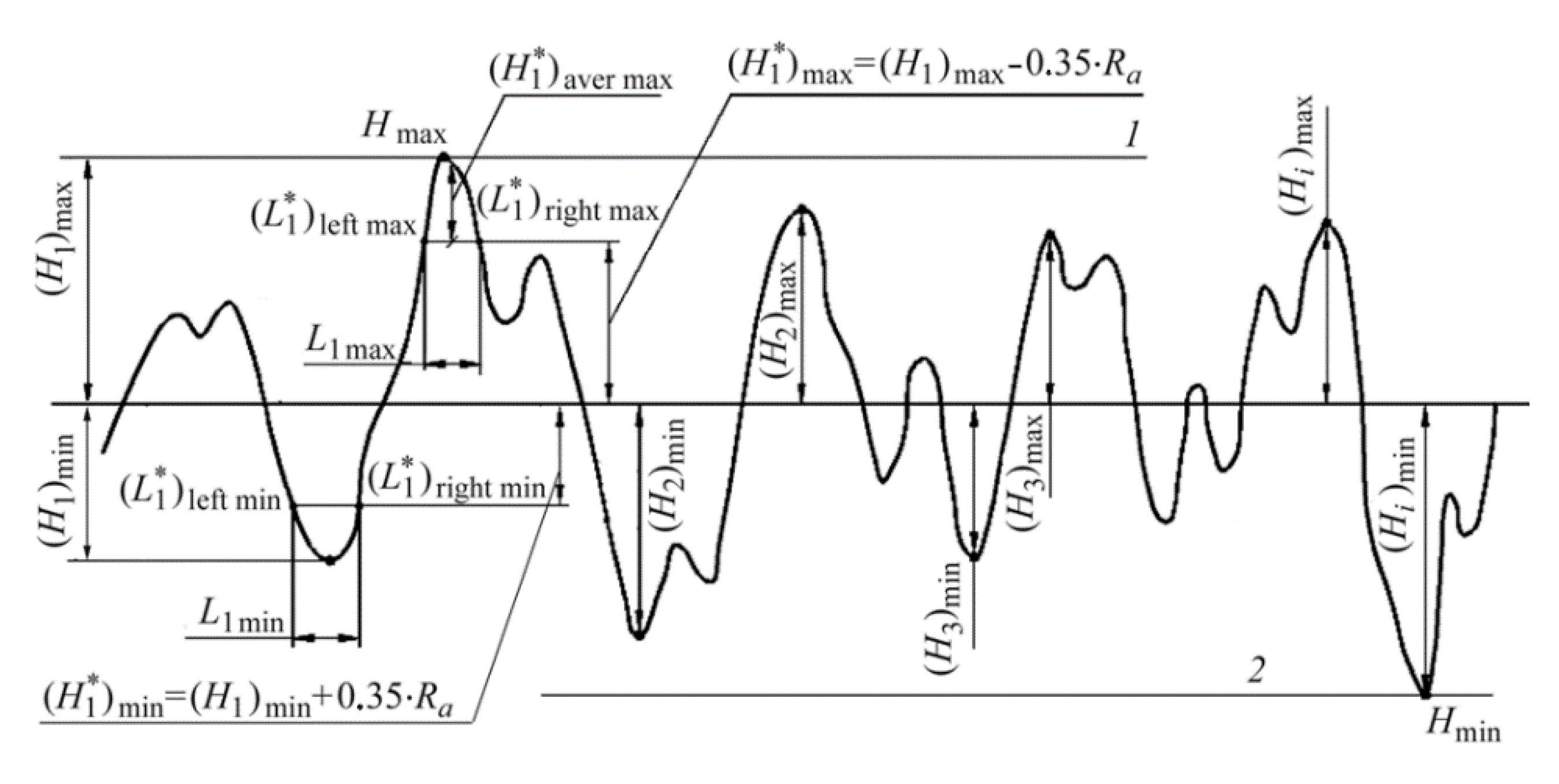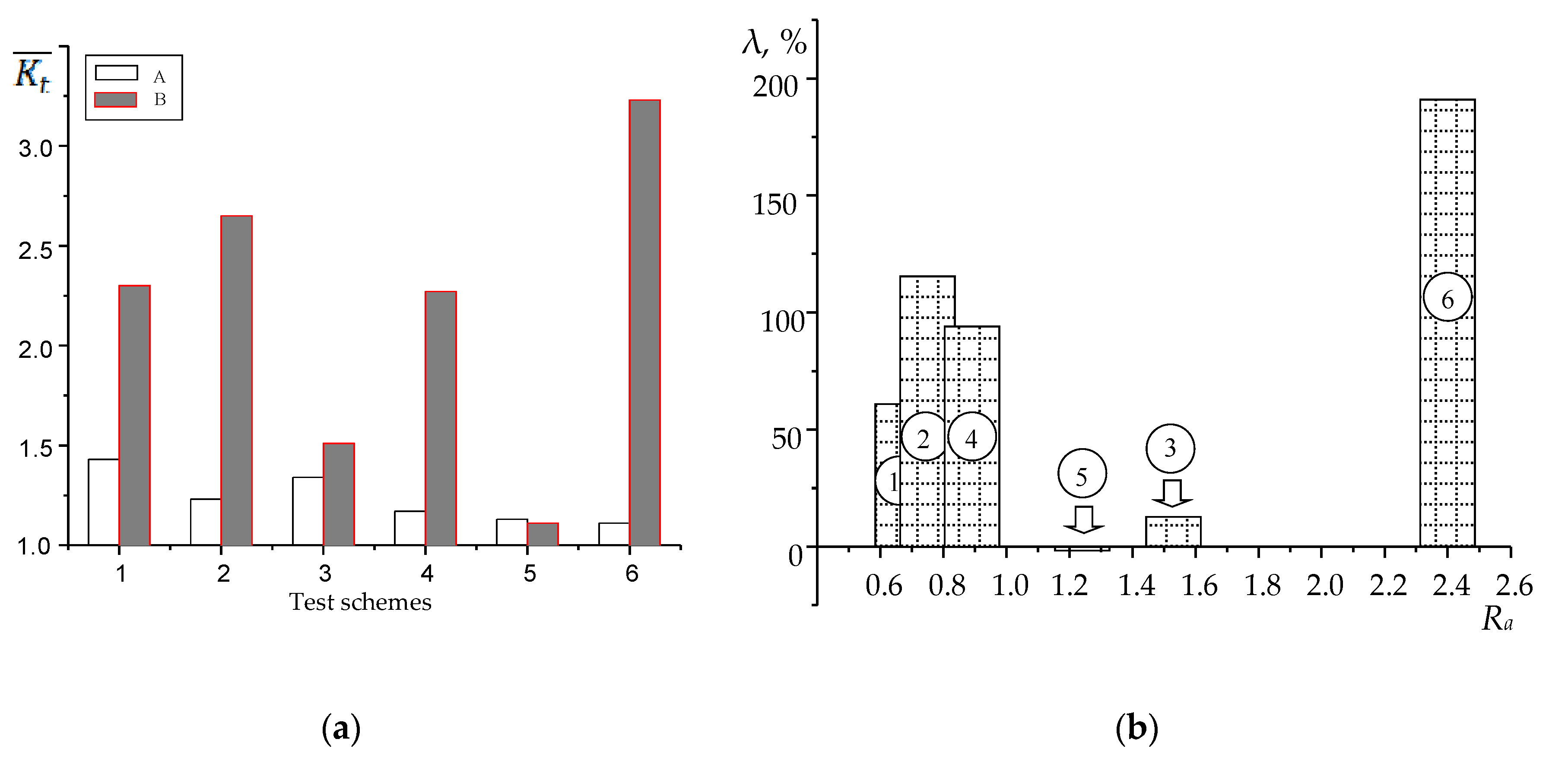Microdefects of Biocorroded Pipe Steel Surfaces and Safety Assessment of Localized Stress Concentrators
Abstract
1. Introduction
2. Materials and Methods
2.1. Test Measurements
2.2. Relationship between Roughness and Stress Concentration Factor
3. Results
4. Discussion
5. Conclusions
Author Contributions
Funding
Conflicts of Interest
References
- Usher, K.M.; Kaksonen, A.H.; Cole, I.; Marney, D. Critical review: Microbially influenced corrosion of buried carbon steel pipes. Int. Biodeterior. Biodegrad. 2014, 93, 84–106. [Google Scholar] [CrossRef]
- Polutrenko, M.S.; Maruschak, P.O.; Prentkovskis, O. The role of the biological factor in the corrosion damage of the metal of undergrund oil and gas pipelines. In Proceedings of the 20th International Conference “Transport Means”, Juodkrantė, Lithuania, 5–7 October 2016; pp. 424–427. [Google Scholar]
- Gu, T.; Jia, R.; Unsal, T.; Xu, D. Toward a better understanding of microbiologically influenced corrosion caused by sulfate reducing bacteria. J. Mater. Sci. Technol. 2019, 35, 631–636. [Google Scholar] [CrossRef]
- Marciales, A.; Peralta, Y.; Haile, T.; Crosby, T.; Wolodko, J. Mechanistic microbiologically influenced corrosion modeling—A review. Corros. Sci. 2019, 146, 99–111. [Google Scholar] [CrossRef]
- Jia, R.; Tan, J.L.; Jin, P.; Blackwood, D.J.; Xu, D.; Gu, T. Effects of biogenic H2S on the microbiologically influenced corrosion of C1018 carbon steel by sulfate reducing Desulfovibrio vulgaris biofilm. Corros. Sci. 2018, 130, 1–11. [Google Scholar] [CrossRef]
- AlAbbas, F.M.; Williamson, C.; Bhola, S.M.; Spear, J.R.; Olson, D.L.; Mishra, B.; Kakpovbia, A.E. Influence of sulfate reducing bacterial biofilm on corrosion behavior of low–alloy, high–strength steel (API–5L X80). Int. Biodeterior. Biodegrad. 2013, 78, 34–42. [Google Scholar] [CrossRef]
- Zerbst, U.; Madia, M.; Klinger, C.; Bettge, D.; Murakami, Y. Defects as a root cause of fatigue failure of metallic components. III: Cavities, dents, corrosion pits, scratches. Eng. Fail. Anal. 2019, 97, 759–776. [Google Scholar] [CrossRef]
- Gibadullin, I.N.; Valetov, V.A. Automated control of component surface microgeometry using graphic images of the profiles. J. Instrum. Eng. 2017, 60, 287–289. (In Russian) [Google Scholar] [CrossRef]
- Gibadullin, I.N.; Valetov, V.A. Image of the surface profile as a graphic criterion of its roughness. J. Instrum. Eng. 2019, 62, 86–92. (In Russian) [Google Scholar] [CrossRef]
- Wade, S.A.; Javed, M.A.; Palombo, E.A.; McArthur, S.L.; Stoddart, P.R. On the need for more realistic experimental conditions in laboratory-based microbiologically influenced corrosion testing. Int. Biodeterior. Biodegrad. 2017, 121, 97–106. [Google Scholar] [CrossRef]
- Wu, T.; Sun, C.; Yan, M.; Xu, J.; Yin, F. Sulfate-reducing bacteria-assisted cracking. Corros. Rev. 2019, 37, 231–244. [Google Scholar] [CrossRef]
- Łabanowski, J.; Rzychoń, T.; Simka, W.; Michalska, J. Sulfate-reducing bacteria-assisted hydrogen-induced stress cracking of 2205 duplex stainless steels. Mater. Corros. 2019, 70, 1667–1681. [Google Scholar] [CrossRef]
- Wasim, M.; Djukic, M.B. Long-term external microbiologically influenced corrosion of buried cast iron pipes in the presence of sulfate-reducing bacteria (SRB). Eng. Fail. Anal. 2020, 115, 104657. [Google Scholar] [CrossRef]
- Maruschak, P.; Konovalenko, I.; Kravets, V.; Romanyshyn, O. New methods of analysis of electron microscopic images and microprofile surfaces of biocorroded steel specimens. In Proceedings of the 7th Scientific and Technical Conference “Information Models, Systems and Technologies”, Ternopil, Ukraine, 1–2 December 2019. [Google Scholar]
- International Organization for Standardization (ISO). 4288:1996 Geometrical product specifications (GPS). In Surface Texture: Profile Method. Rules and Procedures for the Assessment of Surface Texture; ISO: Genève, Switzerland, 1996. [Google Scholar]
- NACE. TM0212-2018-SG Detection, Testing, and Evaluation of Microbiologically Influenced Corrosion on Internal Surfaces of Pipelines; NACE International: Houston, TX, USA, 2018. [Google Scholar]
- Arola, D.; Ramulu, M. An examination of the effects from surface texture on the strength of fiber-reinforced plastics. J. Compos. Mater. 1999, 33, 101–186. [Google Scholar] [CrossRef]
- Arola, D.; Williams, C.L. Estimating the fatigue stress concentration factor of machined surfaces. Int. J. Fatigue 2002, 24, 923–930. [Google Scholar] [CrossRef]
- Polutrenko, M.; Maruschak, P.; Tymoshenko, A.; Sorochak, A. Influence of soil microorganisms on metal corrosion of underground pipelines. Koroze Ochr. Mater. 2018, 62, 54–59. [Google Scholar] [CrossRef][Green Version]
- Kuang, F.; Wang, J.; Yan, L.; Zhang, D. Effects of sulfate–reducing bacteria on the corrosion behavior of carbon steel. Electrochim. Acta 2007, 52, 6084–6088. [Google Scholar] [CrossRef]
- Kragelsky, I.V.; Rudzit, Y.A. Method of determining the mean values of the radii of curvature of the asperity tips of a roughness profile. Proborostroyenie 1968, 3, 15–24. [Google Scholar]
- Pogrebova, I.S.; Kozlova, I.A.; Purish, L.M.; Gerasika, S.E.; Tuovinen, O.H. Mechanism of inhibition of corrosion of steel in the presence of sulfate-reducing bacteria. Mater. Sci. 2001, 37, 754–761. [Google Scholar] [CrossRef]
- Polutrenko, M.; Maruschak, P.; Prentkovskis, O.; Tymoshenko, A.; Maruschak, O. Impact of Sulfate Reducing Bacteria on Biocorrosion of Pipeline Steels. In Reliability and Statistics in Transportation and Communication—2018, Lecture Notes in Networks and Systems; Kabashkin, I., Yatskiv, I., Prentkovskis, O., Eds.; Springer: Berlin/Heidelberg, Germany, 2019; Volume 68, pp. 530–538. [Google Scholar] [CrossRef]
- Khamaza, L.A. Generalized diagram of the ultimate nominal stresses (endurance limit) and the corresponding dimensions of the non-propagating fatigue cracks for sharp and blunt notches. Strength Mater. 2019, 51, 350–360. [Google Scholar] [CrossRef]
- Maruschak, P.; Panin, S.; Vlasov, I.; Prentkovskis, O.; Danyliuk, I. Structural levels of the nucleation and growth of fatigue crack in 17Mn1Si steel pipeline after long-term service. Transport 2015, 30, 15–23. [Google Scholar] [CrossRef]



| Steel | Chemical Composition, % | ||||||||||
|---|---|---|---|---|---|---|---|---|---|---|---|
| C | Si | Mn | Ni | S | P | Cr | V | N | Cu | As | |
| 20 | 0.17–0.24 | 0.17–0.37 | 0.35–0.65 | ≤0.25 | ≤0.035 | ≤0.035 | ≤0.25 | - | - | - | - |
| Test Schemes | Medium | Kgr, mg/dm2·days |
|---|---|---|
| 1 | Postgate’s medium | 3.0 |
| 2 | Postgate’s medium + SRB | 2.9 |
| 3 | Postgate’s medium + SRB + 1 inh. 0.5% | 4.8 |
| 4 | Postgate’s medium + SRB + 1 inh. 1.0% | 0.9 |
| 5 | Postgate’s medium + SRB + 2 inh. 0.5% | 1.0 |
| 6 | Postgate’s medium + SRB + 2 inh. 1.0% | 0.5 |
| Test Schemes | Rz | Ra µm | Ry |
|---|---|---|---|
| 1 | 4.09/4.12 | 0.50/0.67 | 8.24/5.16 |
| 2 | 4.13/7.23 | 0.57/0.75 | 6.72/9.42 |
| 3 | 5.30/8.95 | 0.98/1.53 | 6.65/12.03 |
| 4 | 4.13/5.63 | 0.62/0.89 | 5.63/6.86 |
| 5 | 3.61/7.66 | 0.52/1.24 | 5.15/11.04 |
| 6 | 3.10/22.17 | 0.50/2.40 | 3.34/39.29 |
© 2020 by the authors. Licensee MDPI, Basel, Switzerland. This article is an open access article distributed under the terms and conditions of the Creative Commons Attribution (CC BY) license (http://creativecommons.org/licenses/by/4.0/).
Share and Cite
Maruschak, P.; Dzyura, V.; Prentkovskis, O.; Lytvynenko, I.; Polutrenko, M. Microdefects of Biocorroded Pipe Steel Surfaces and Safety Assessment of Localized Stress Concentrators. Metals 2020, 10, 852. https://doi.org/10.3390/met10070852
Maruschak P, Dzyura V, Prentkovskis O, Lytvynenko I, Polutrenko M. Microdefects of Biocorroded Pipe Steel Surfaces and Safety Assessment of Localized Stress Concentrators. Metals. 2020; 10(7):852. https://doi.org/10.3390/met10070852
Chicago/Turabian StyleMaruschak, Pavlo, Volodymyr Dzyura, Olegas Prentkovskis, Iaroslav Lytvynenko, and Myroslava Polutrenko. 2020. "Microdefects of Biocorroded Pipe Steel Surfaces and Safety Assessment of Localized Stress Concentrators" Metals 10, no. 7: 852. https://doi.org/10.3390/met10070852
APA StyleMaruschak, P., Dzyura, V., Prentkovskis, O., Lytvynenko, I., & Polutrenko, M. (2020). Microdefects of Biocorroded Pipe Steel Surfaces and Safety Assessment of Localized Stress Concentrators. Metals, 10(7), 852. https://doi.org/10.3390/met10070852








